Business Strategy Report: Strategic Planning & Implementation
VerifiedAdded on 2019/12/04
|17
|5010
|201
Report
AI Summary
This report provides a comprehensive analysis of business strategy, encompassing mission, vision, objectives, and core competencies. It delves into factors crucial for strategic planning, techniques for developing strategic plans, and the effectiveness of tools like SWOT, SPACE, and PESTLE analysis. The report includes an organizational and environmental audit of McDonald's, stakeholder analysis, and the formulation of a new strategy for the company. Furthermore, it explores alternative strategies for market entry, growth, and retrenchment, with a focus on Marks & Spencer (M&S). The report also examines the roles and responsibilities in strategy implementation, resource requirements, and the contribution of SMART targets, using Honda as a case study. The report concludes by emphasizing the importance of effective strategic planning and implementation in achieving business objectives.
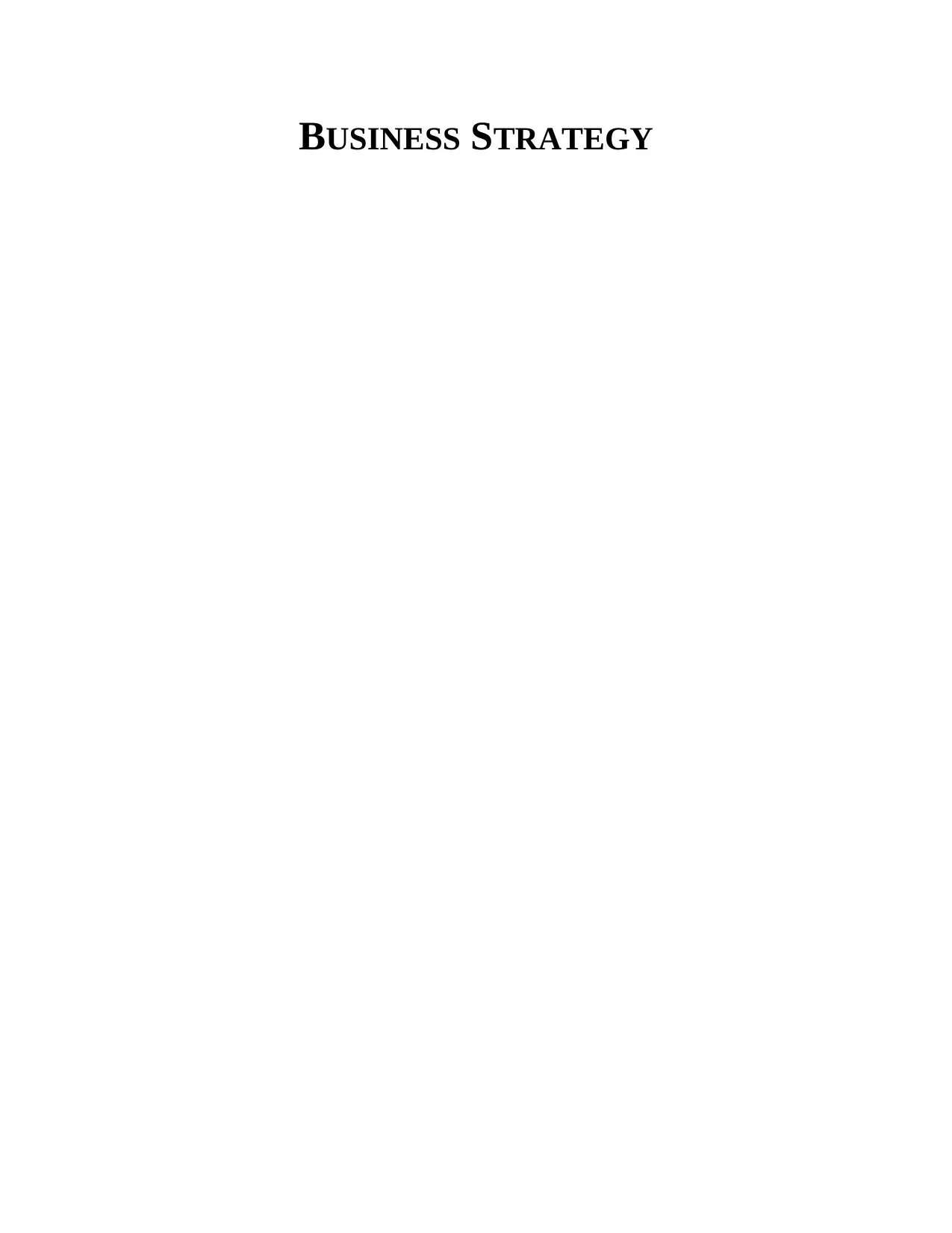
BUSINESS STRATEGY
Paraphrase This Document
Need a fresh take? Get an instant paraphrase of this document with our AI Paraphraser
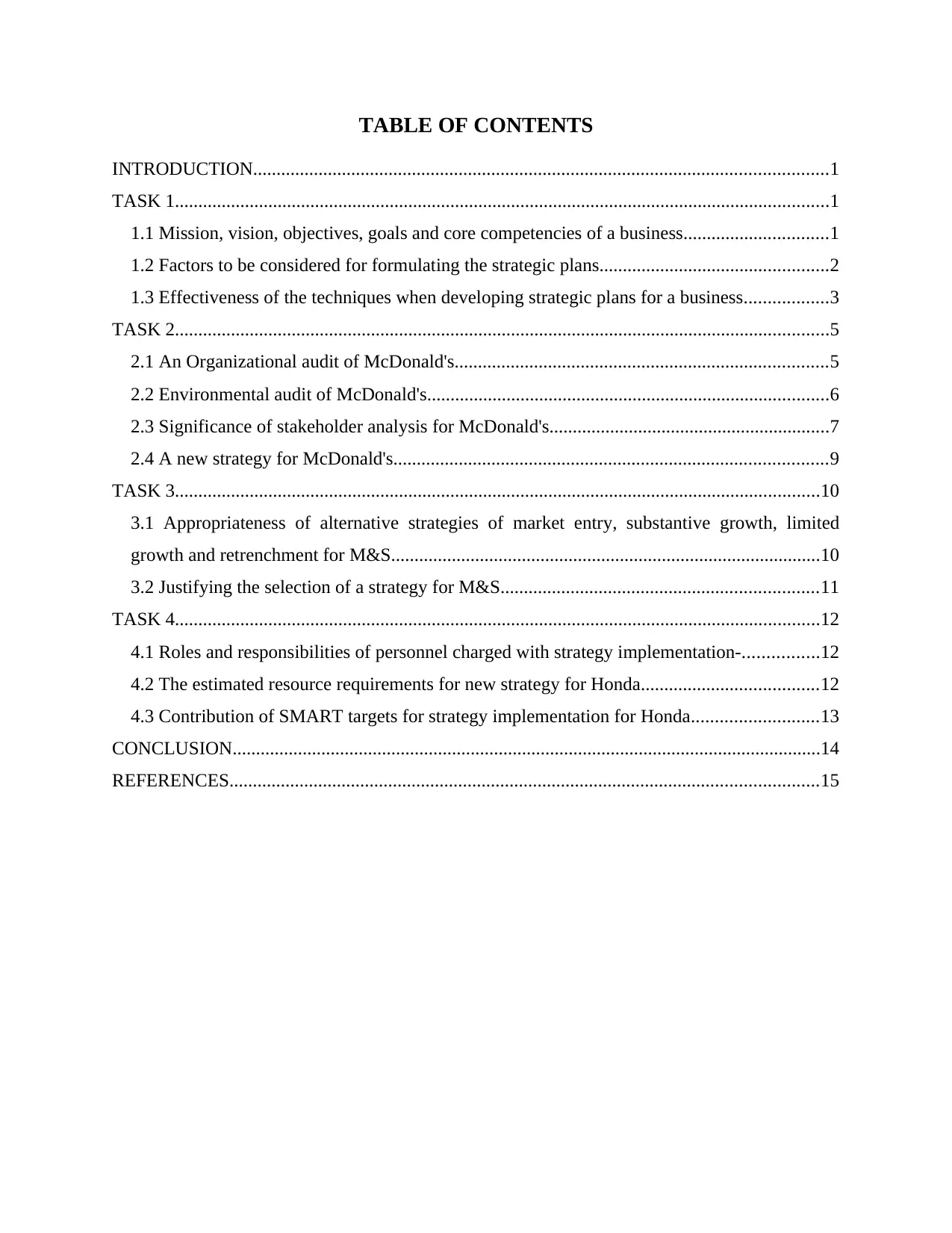
TABLE OF CONTENTS
INTRODUCTION...........................................................................................................................1
TASK 1............................................................................................................................................1
1.1 Mission, vision, objectives, goals and core competencies of a business...............................1
1.2 Factors to be considered for formulating the strategic plans.................................................2
1.3 Effectiveness of the techniques when developing strategic plans for a business..................3
TASK 2............................................................................................................................................5
2.1 An Organizational audit of McDonald's................................................................................5
2.2 Environmental audit of McDonald's......................................................................................6
2.3 Significance of stakeholder analysis for McDonald's............................................................7
2.4 A new strategy for McDonald's.............................................................................................9
TASK 3..........................................................................................................................................10
3.1 Appropriateness of alternative strategies of market entry, substantive growth, limited
growth and retrenchment for M&S............................................................................................10
3.2 Justifying the selection of a strategy for M&S....................................................................11
TASK 4..........................................................................................................................................12
4.1 Roles and responsibilities of personnel charged with strategy implementation-................12
4.2 The estimated resource requirements for new strategy for Honda......................................12
4.3 Contribution of SMART targets for strategy implementation for Honda...........................13
CONCLUSION..............................................................................................................................14
REFERENCES..............................................................................................................................15
INTRODUCTION...........................................................................................................................1
TASK 1............................................................................................................................................1
1.1 Mission, vision, objectives, goals and core competencies of a business...............................1
1.2 Factors to be considered for formulating the strategic plans.................................................2
1.3 Effectiveness of the techniques when developing strategic plans for a business..................3
TASK 2............................................................................................................................................5
2.1 An Organizational audit of McDonald's................................................................................5
2.2 Environmental audit of McDonald's......................................................................................6
2.3 Significance of stakeholder analysis for McDonald's............................................................7
2.4 A new strategy for McDonald's.............................................................................................9
TASK 3..........................................................................................................................................10
3.1 Appropriateness of alternative strategies of market entry, substantive growth, limited
growth and retrenchment for M&S............................................................................................10
3.2 Justifying the selection of a strategy for M&S....................................................................11
TASK 4..........................................................................................................................................12
4.1 Roles and responsibilities of personnel charged with strategy implementation-................12
4.2 The estimated resource requirements for new strategy for Honda......................................12
4.3 Contribution of SMART targets for strategy implementation for Honda...........................13
CONCLUSION..............................................................................................................................14
REFERENCES..............................................................................................................................15
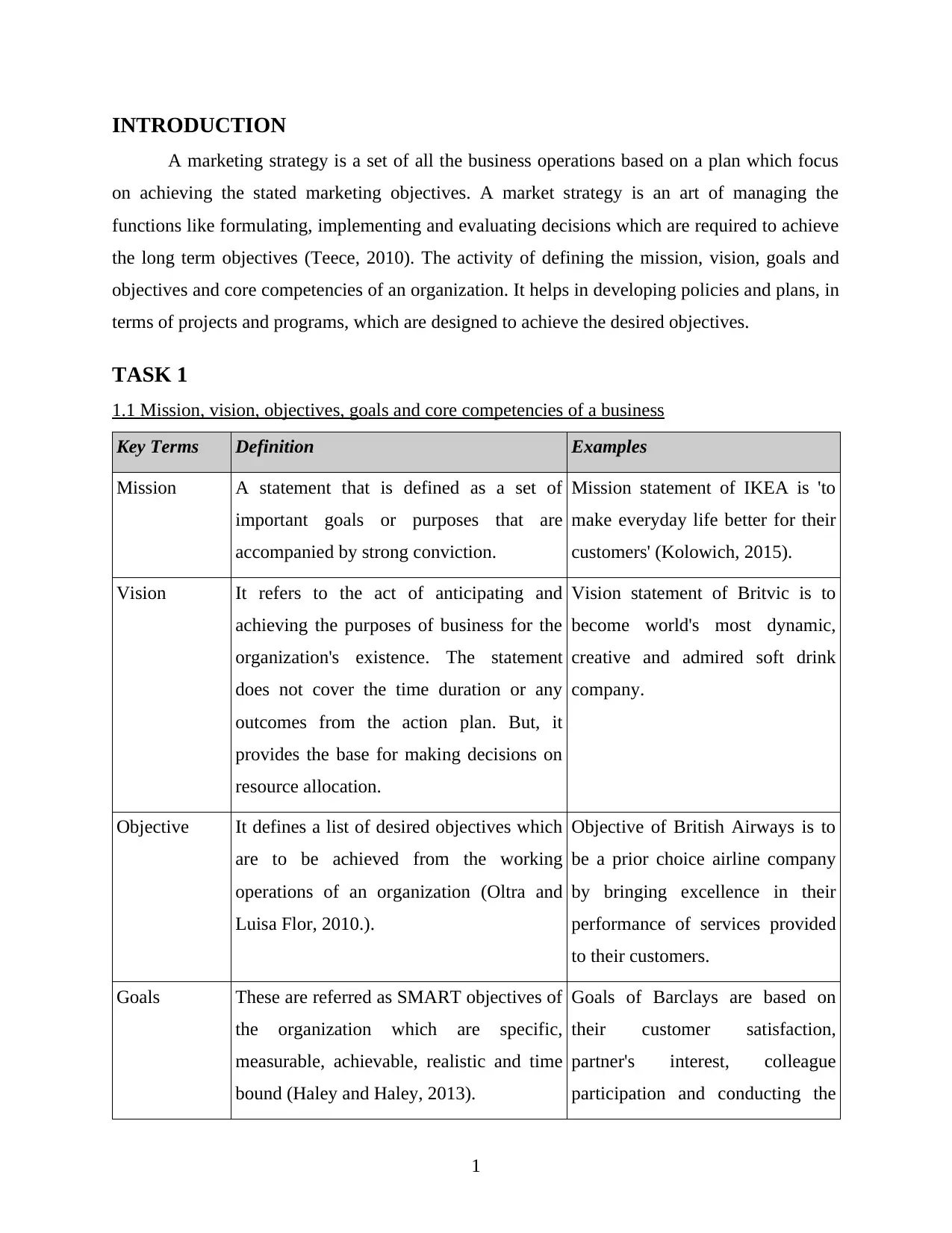
INTRODUCTION
A marketing strategy is a set of all the business operations based on a plan which focus
on achieving the stated marketing objectives. A market strategy is an art of managing the
functions like formulating, implementing and evaluating decisions which are required to achieve
the long term objectives (Teece, 2010). The activity of defining the mission, vision, goals and
objectives and core competencies of an organization. It helps in developing policies and plans, in
terms of projects and programs, which are designed to achieve the desired objectives.
TASK 1
1.1 Mission, vision, objectives, goals and core competencies of a business
Key Terms Definition Examples
Mission A statement that is defined as a set of
important goals or purposes that are
accompanied by strong conviction.
Mission statement of IKEA is 'to
make everyday life better for their
customers' (Kolowich, 2015).
Vision It refers to the act of anticipating and
achieving the purposes of business for the
organization's existence. The statement
does not cover the time duration or any
outcomes from the action plan. But, it
provides the base for making decisions on
resource allocation.
Vision statement of Britvic is to
become world's most dynamic,
creative and admired soft drink
company.
Objective It defines a list of desired objectives which
are to be achieved from the working
operations of an organization (Oltra and
Luisa Flor, 2010.).
Objective of British Airways is to
be a prior choice airline company
by bringing excellence in their
performance of services provided
to their customers.
Goals These are referred as SMART objectives of
the organization which are specific,
measurable, achievable, realistic and time
bound (Haley and Haley, 2013).
Goals of Barclays are based on
their customer satisfaction,
partner's interest, colleague
participation and conducting the
1
A marketing strategy is a set of all the business operations based on a plan which focus
on achieving the stated marketing objectives. A market strategy is an art of managing the
functions like formulating, implementing and evaluating decisions which are required to achieve
the long term objectives (Teece, 2010). The activity of defining the mission, vision, goals and
objectives and core competencies of an organization. It helps in developing policies and plans, in
terms of projects and programs, which are designed to achieve the desired objectives.
TASK 1
1.1 Mission, vision, objectives, goals and core competencies of a business
Key Terms Definition Examples
Mission A statement that is defined as a set of
important goals or purposes that are
accompanied by strong conviction.
Mission statement of IKEA is 'to
make everyday life better for their
customers' (Kolowich, 2015).
Vision It refers to the act of anticipating and
achieving the purposes of business for the
organization's existence. The statement
does not cover the time duration or any
outcomes from the action plan. But, it
provides the base for making decisions on
resource allocation.
Vision statement of Britvic is to
become world's most dynamic,
creative and admired soft drink
company.
Objective It defines a list of desired objectives which
are to be achieved from the working
operations of an organization (Oltra and
Luisa Flor, 2010.).
Objective of British Airways is to
be a prior choice airline company
by bringing excellence in their
performance of services provided
to their customers.
Goals These are referred as SMART objectives of
the organization which are specific,
measurable, achievable, realistic and time
bound (Haley and Haley, 2013).
Goals of Barclays are based on
their customer satisfaction,
partner's interest, colleague
participation and conducting the
1
⊘ This is a preview!⊘
Do you want full access?
Subscribe today to unlock all pages.

Trusted by 1+ million students worldwide

business.
Core
Competencies
Capabilities of the organization to compete
in the marketplace, in order to deliver
values to customers and increase
contribution in its wealth.
Core competencies of Zara
(Inditex) are related to the higher
value of its products from its
competitor's products. Their
products are rare to find and are
available for limited edition as
well as period.
Strategic planning – It refers to the process of organizational planning which is based on
the set activities of allocating resources, making decisions, ensuring that employees and
other stakeholders are working towards the common goals (Haley, Haley and Tan, 2011).
Presence of all the components such as mission, vision, objectives etc. is very necessary
to formulate a strategic plan for the organization. It also helps in extending the control
mechanisms for guiding and implementing the strategy into the organization structure.
1.2 Factors to be considered for formulating the strategic plans
Management of the organization should consider some major factors while formulating
and developing the strategic planning for the business operations. Factors which are to be
considered are: Persons to consult and involve during the process – They are referred as a group of
stakeholders in the organization which provides better knowledge for formulating
strategies (Montgomery, 2011). Influence on targets –Factors to be considered in order to maintain the level of achieving
targets are balancing the brand loyalty and its name, rising the customer satisfaction,
leading the market position, etc. Impact on managers - Factors like rising the efficiency, allocating more resources,
executing the operations, etc. could affect the working condition of managers.
Requirement of Strategic planning – An organization should attain the requirement of
planning a strategic structure and design, when it suffers from the conditions like low
productivity, low profitability and decrease in market growth (Wantao and et.al., 2012).
2
Core
Competencies
Capabilities of the organization to compete
in the marketplace, in order to deliver
values to customers and increase
contribution in its wealth.
Core competencies of Zara
(Inditex) are related to the higher
value of its products from its
competitor's products. Their
products are rare to find and are
available for limited edition as
well as period.
Strategic planning – It refers to the process of organizational planning which is based on
the set activities of allocating resources, making decisions, ensuring that employees and
other stakeholders are working towards the common goals (Haley, Haley and Tan, 2011).
Presence of all the components such as mission, vision, objectives etc. is very necessary
to formulate a strategic plan for the organization. It also helps in extending the control
mechanisms for guiding and implementing the strategy into the organization structure.
1.2 Factors to be considered for formulating the strategic plans
Management of the organization should consider some major factors while formulating
and developing the strategic planning for the business operations. Factors which are to be
considered are: Persons to consult and involve during the process – They are referred as a group of
stakeholders in the organization which provides better knowledge for formulating
strategies (Montgomery, 2011). Influence on targets –Factors to be considered in order to maintain the level of achieving
targets are balancing the brand loyalty and its name, rising the customer satisfaction,
leading the market position, etc. Impact on managers - Factors like rising the efficiency, allocating more resources,
executing the operations, etc. could affect the working condition of managers.
Requirement of Strategic planning – An organization should attain the requirement of
planning a strategic structure and design, when it suffers from the conditions like low
productivity, low profitability and decrease in market growth (Wantao and et.al., 2012).
2
Paraphrase This Document
Need a fresh take? Get an instant paraphrase of this document with our AI Paraphraser
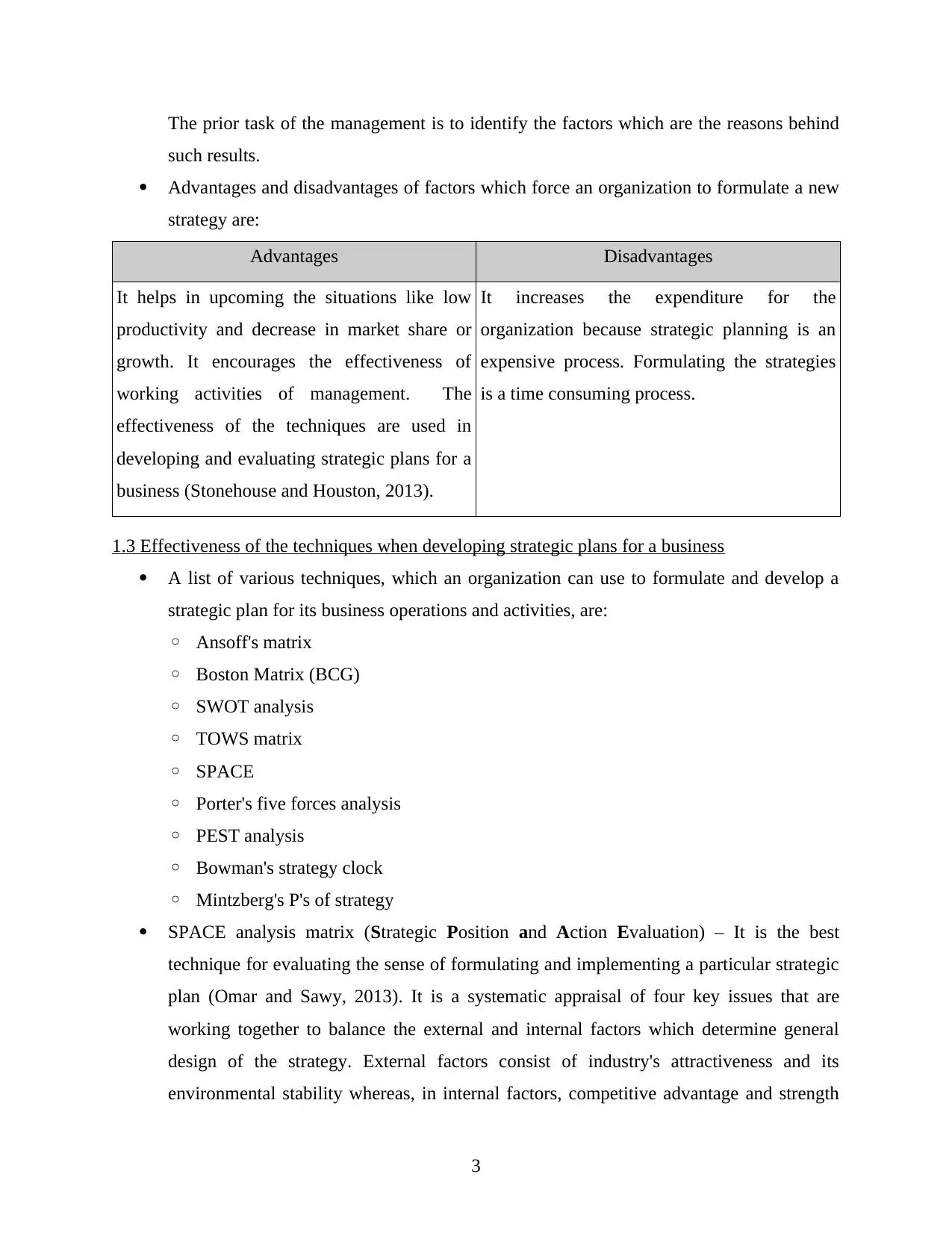
The prior task of the management is to identify the factors which are the reasons behind
such results.
Advantages and disadvantages of factors which force an organization to formulate a new
strategy are:
Advantages Disadvantages
It helps in upcoming the situations like low
productivity and decrease in market share or
growth. It encourages the effectiveness of
working activities of management. The
effectiveness of the techniques are used in
developing and evaluating strategic plans for a
business (Stonehouse and Houston, 2013).
It increases the expenditure for the
organization because strategic planning is an
expensive process. Formulating the strategies
is a time consuming process.
1.3 Effectiveness of the techniques when developing strategic plans for a business
A list of various techniques, which an organization can use to formulate and develop a
strategic plan for its business operations and activities, are:
◦ Ansoff's matrix
◦ Boston Matrix (BCG)
◦ SWOT analysis
◦ TOWS matrix
◦ SPACE
◦ Porter's five forces analysis
◦ PEST analysis
◦ Bowman's strategy clock
◦ Mintzberg's P's of strategy
SPACE analysis matrix (Strategic Position and Action Evaluation) – It is the best
technique for evaluating the sense of formulating and implementing a particular strategic
plan (Omar and Sawy, 2013). It is a systematic appraisal of four key issues that are
working together to balance the external and internal factors which determine general
design of the strategy. External factors consist of industry's attractiveness and its
environmental stability whereas, in internal factors, competitive advantage and strength
3
such results.
Advantages and disadvantages of factors which force an organization to formulate a new
strategy are:
Advantages Disadvantages
It helps in upcoming the situations like low
productivity and decrease in market share or
growth. It encourages the effectiveness of
working activities of management. The
effectiveness of the techniques are used in
developing and evaluating strategic plans for a
business (Stonehouse and Houston, 2013).
It increases the expenditure for the
organization because strategic planning is an
expensive process. Formulating the strategies
is a time consuming process.
1.3 Effectiveness of the techniques when developing strategic plans for a business
A list of various techniques, which an organization can use to formulate and develop a
strategic plan for its business operations and activities, are:
◦ Ansoff's matrix
◦ Boston Matrix (BCG)
◦ SWOT analysis
◦ TOWS matrix
◦ SPACE
◦ Porter's five forces analysis
◦ PEST analysis
◦ Bowman's strategy clock
◦ Mintzberg's P's of strategy
SPACE analysis matrix (Strategic Position and Action Evaluation) – It is the best
technique for evaluating the sense of formulating and implementing a particular strategic
plan (Omar and Sawy, 2013). It is a systematic appraisal of four key issues that are
working together to balance the external and internal factors which determine general
design of the strategy. External factors consist of industry's attractiveness and its
environmental stability whereas, in internal factors, competitive advantage and strength
3
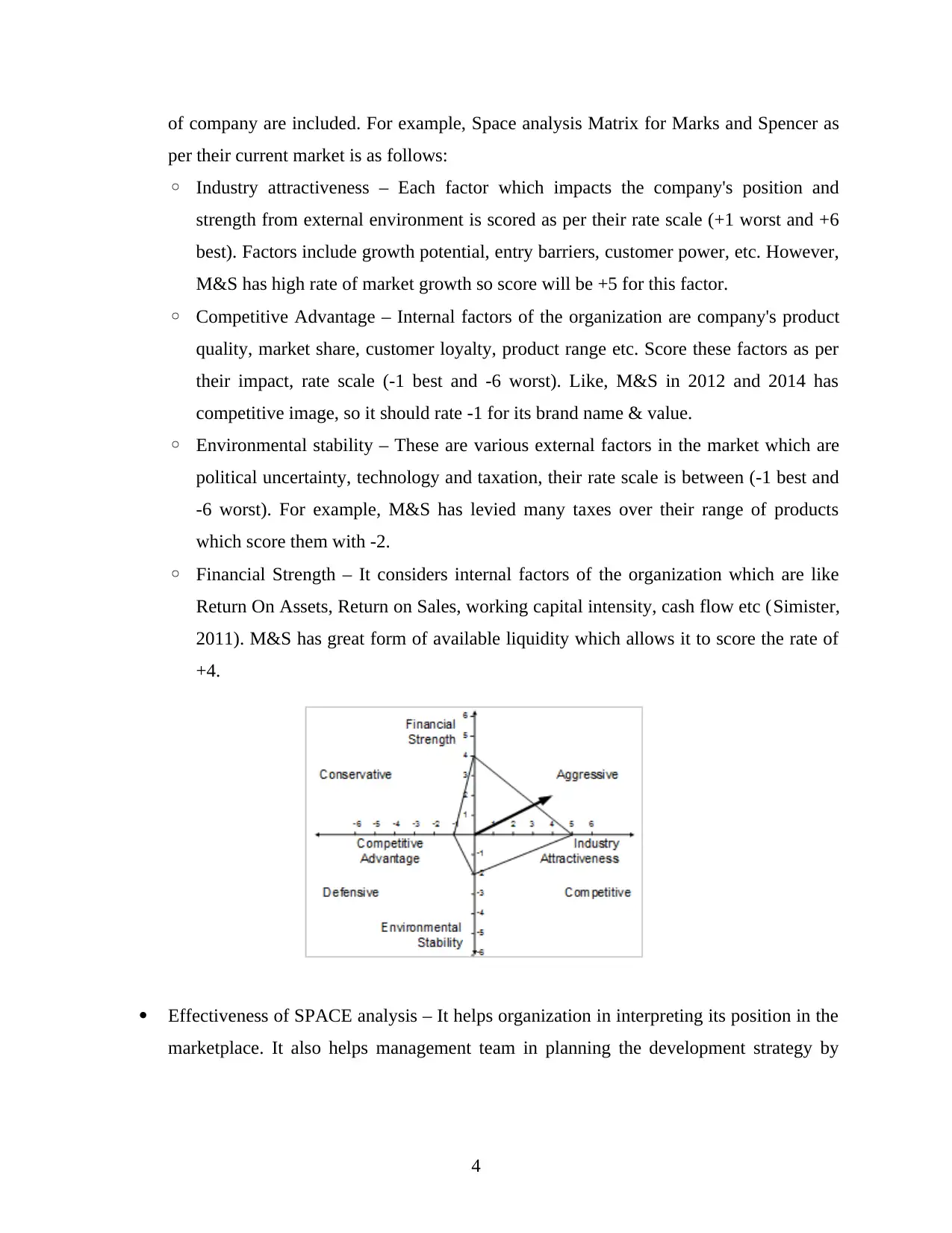
of company are included. For example, Space analysis Matrix for Marks and Spencer as
per their current market is as follows:
◦ Industry attractiveness – Each factor which impacts the company's position and
strength from external environment is scored as per their rate scale (+1 worst and +6
best). Factors include growth potential, entry barriers, customer power, etc. However,
M&S has high rate of market growth so score will be +5 for this factor.
◦ Competitive Advantage – Internal factors of the organization are company's product
quality, market share, customer loyalty, product range etc. Score these factors as per
their impact, rate scale (-1 best and -6 worst). Like, M&S in 2012 and 2014 has
competitive image, so it should rate -1 for its brand name & value.
◦ Environmental stability – These are various external factors in the market which are
political uncertainty, technology and taxation, their rate scale is between (-1 best and
-6 worst). For example, M&S has levied many taxes over their range of products
which score them with -2.
◦ Financial Strength – It considers internal factors of the organization which are like
Return On Assets, Return on Sales, working capital intensity, cash flow etc (Simister,
2011). M&S has great form of available liquidity which allows it to score the rate of
+4.
Effectiveness of SPACE analysis – It helps organization in interpreting its position in the
marketplace. It also helps management team in planning the development strategy by
4
per their current market is as follows:
◦ Industry attractiveness – Each factor which impacts the company's position and
strength from external environment is scored as per their rate scale (+1 worst and +6
best). Factors include growth potential, entry barriers, customer power, etc. However,
M&S has high rate of market growth so score will be +5 for this factor.
◦ Competitive Advantage – Internal factors of the organization are company's product
quality, market share, customer loyalty, product range etc. Score these factors as per
their impact, rate scale (-1 best and -6 worst). Like, M&S in 2012 and 2014 has
competitive image, so it should rate -1 for its brand name & value.
◦ Environmental stability – These are various external factors in the market which are
political uncertainty, technology and taxation, their rate scale is between (-1 best and
-6 worst). For example, M&S has levied many taxes over their range of products
which score them with -2.
◦ Financial Strength – It considers internal factors of the organization which are like
Return On Assets, Return on Sales, working capital intensity, cash flow etc (Simister,
2011). M&S has great form of available liquidity which allows it to score the rate of
+4.
Effectiveness of SPACE analysis – It helps organization in interpreting its position in the
marketplace. It also helps management team in planning the development strategy by
4
⊘ This is a preview!⊘
Do you want full access?
Subscribe today to unlock all pages.

Trusted by 1+ million students worldwide

analyzing four different dimensions and assessing their efficiency in order to rank their
impact in the form of scores (Murthy, 2012).
TASK 2
2.1 An Organizational audit of McDonald's
Organizational audit refers to the analysis made up by an auditor in order to achieve some
specific objectives when conducting the fieldwork phase of the audit (Mama and Kruger,
2012). These objectives include:
◦ To identify the organization's risks and ensure to manage them.
◦ To comply the employees with the organization's regulations and policies.
◦ To ensure an effective use of organization's resources.
Some organizational audits are SWOT (Strength, Weakness, Opportunity and Threat),
Value chain analysis, Benchmarking, etc.
Swot analysis of McDonald's
Strength Weakness
Customer familiarity with all the
products.
High price range of products.
Legal issues related to health and safety
5
Illustration 1: Swot analysis
impact in the form of scores (Murthy, 2012).
TASK 2
2.1 An Organizational audit of McDonald's
Organizational audit refers to the analysis made up by an auditor in order to achieve some
specific objectives when conducting the fieldwork phase of the audit (Mama and Kruger,
2012). These objectives include:
◦ To identify the organization's risks and ensure to manage them.
◦ To comply the employees with the organization's regulations and policies.
◦ To ensure an effective use of organization's resources.
Some organizational audits are SWOT (Strength, Weakness, Opportunity and Threat),
Value chain analysis, Benchmarking, etc.
Swot analysis of McDonald's
Strength Weakness
Customer familiarity with all the
products.
High price range of products.
Legal issues related to health and safety
5
Illustration 1: Swot analysis
Paraphrase This Document
Need a fresh take? Get an instant paraphrase of this document with our AI Paraphraser
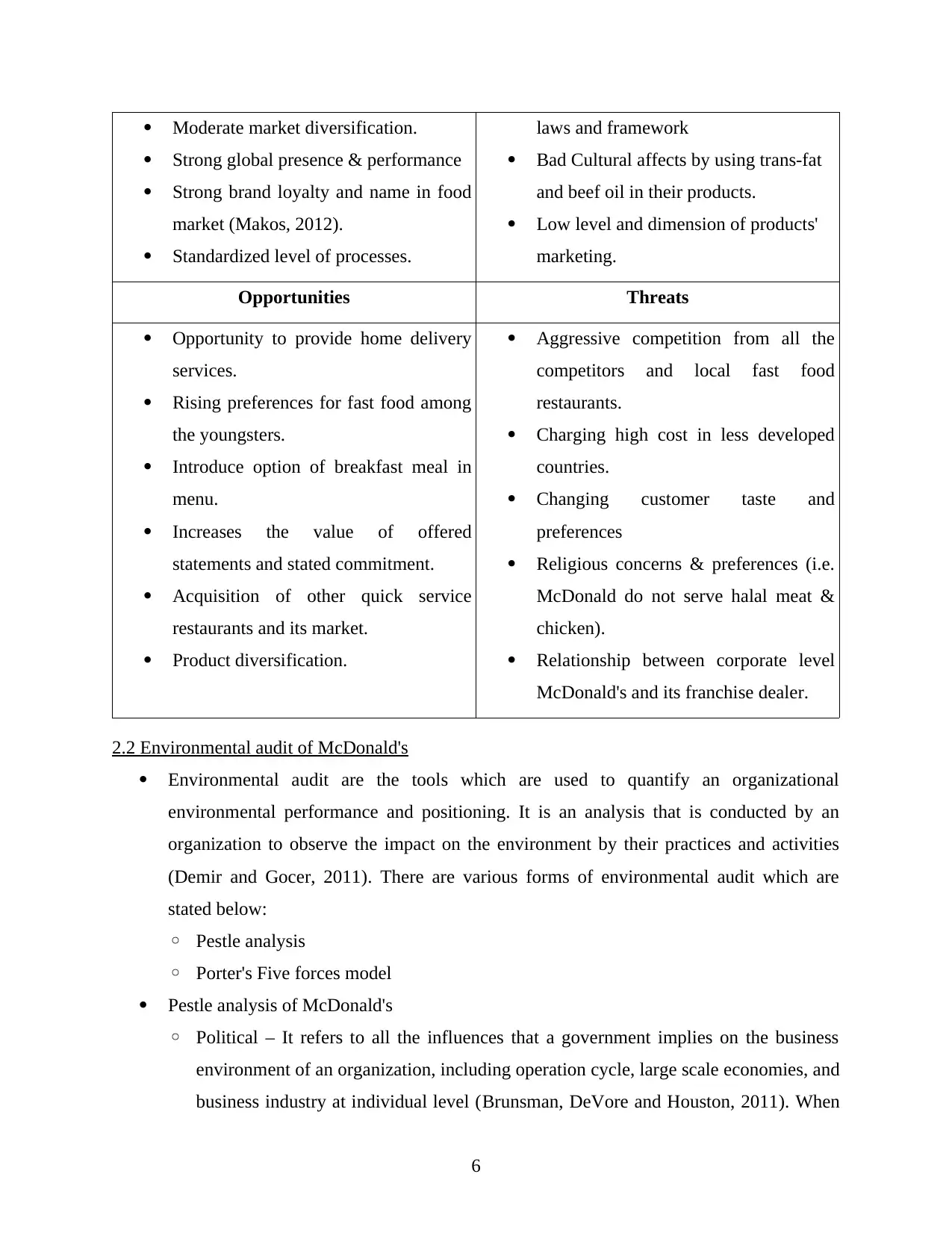
Moderate market diversification.
Strong global presence & performance
Strong brand loyalty and name in food
market (Makos, 2012).
Standardized level of processes.
laws and framework
Bad Cultural affects by using trans-fat
and beef oil in their products.
Low level and dimension of products'
marketing.
Opportunities Threats
Opportunity to provide home delivery
services.
Rising preferences for fast food among
the youngsters.
Introduce option of breakfast meal in
menu.
Increases the value of offered
statements and stated commitment.
Acquisition of other quick service
restaurants and its market.
Product diversification.
Aggressive competition from all the
competitors and local fast food
restaurants.
Charging high cost in less developed
countries.
Changing customer taste and
preferences
Religious concerns & preferences (i.e.
McDonald do not serve halal meat &
chicken).
Relationship between corporate level
McDonald's and its franchise dealer.
2.2 Environmental audit of McDonald's
Environmental audit are the tools which are used to quantify an organizational
environmental performance and positioning. It is an analysis that is conducted by an
organization to observe the impact on the environment by their practices and activities
(Demir and Gocer, 2011). There are various forms of environmental audit which are
stated below:
◦ Pestle analysis
◦ Porter's Five forces model
Pestle analysis of McDonald's
◦ Political – It refers to all the influences that a government implies on the business
environment of an organization, including operation cycle, large scale economies, and
business industry at individual level (Brunsman, DeVore and Houston, 2011). When
6
Strong global presence & performance
Strong brand loyalty and name in food
market (Makos, 2012).
Standardized level of processes.
laws and framework
Bad Cultural affects by using trans-fat
and beef oil in their products.
Low level and dimension of products'
marketing.
Opportunities Threats
Opportunity to provide home delivery
services.
Rising preferences for fast food among
the youngsters.
Introduce option of breakfast meal in
menu.
Increases the value of offered
statements and stated commitment.
Acquisition of other quick service
restaurants and its market.
Product diversification.
Aggressive competition from all the
competitors and local fast food
restaurants.
Charging high cost in less developed
countries.
Changing customer taste and
preferences
Religious concerns & preferences (i.e.
McDonald do not serve halal meat &
chicken).
Relationship between corporate level
McDonald's and its franchise dealer.
2.2 Environmental audit of McDonald's
Environmental audit are the tools which are used to quantify an organizational
environmental performance and positioning. It is an analysis that is conducted by an
organization to observe the impact on the environment by their practices and activities
(Demir and Gocer, 2011). There are various forms of environmental audit which are
stated below:
◦ Pestle analysis
◦ Porter's Five forces model
Pestle analysis of McDonald's
◦ Political – It refers to all the influences that a government implies on the business
environment of an organization, including operation cycle, large scale economies, and
business industry at individual level (Brunsman, DeVore and Houston, 2011). When
6

government increases the tax reforms, it becomes hard for McDonald's in operating
their business activities.
◦ Economic – This analyzes the economy factors which impact the performance of an
organization in global trends of market. For McDonald's the impacts of inflation rates
are vital for their business activities. Along with this, the influences of interest rates,
economic growth, changing demand and supply trends are all analyzed under this
section.
◦ Social – It includes the major factors which impact the cultural and social trends like
demographic shifts, social attitudes & cultural beliefs and fashion cycles. However, in
case of McDonald's, the social factors are the issues related to product safety,
workplace safety, employee opportunities and training, the environment and
sustainable supply chain initiatives.
◦ Technological – This reflects to the technological factors that are impacting the
business environment. It measures the direct and indirect impact of technology trends
over the business (Cockayne and Mears, 2011).
◦ Legal – There are various laws and policies that have a direct impact on the business
activities. These legal framework includes social laws, regulatory laws, standards
which are to maintained by the organization in their business operations. McDonald's
has to concern and work as per the changing legal framework of the food market.
◦ Environmental – It refers to the analysis of the business effects in its operating
environment. McDonald's has to focus on maintaining the surrounding environment
and resources along with their business operations.
2.3 Significance of stakeholder analysis for McDonald's
Stakeholders refer to any individual, organization, social group or community that has a
interest or share in the business of an industry. They can be internal or external to the
business. They can affect or be affected by the organization's actions, objectives and
policies (Loorbach and et.al., 2010). Examples of stakeholders are: creditors, directors,
government, shareholders, employees, suppliers, etc.
Stakeholder analysis is a method which is used to facilitate institutional and policy
reform activities by accounting for and often incorporating the needs of the parties having
interest or any stake in the reforms under consideration (Althonayan and Sharif, 2010). It
7
their business activities.
◦ Economic – This analyzes the economy factors which impact the performance of an
organization in global trends of market. For McDonald's the impacts of inflation rates
are vital for their business activities. Along with this, the influences of interest rates,
economic growth, changing demand and supply trends are all analyzed under this
section.
◦ Social – It includes the major factors which impact the cultural and social trends like
demographic shifts, social attitudes & cultural beliefs and fashion cycles. However, in
case of McDonald's, the social factors are the issues related to product safety,
workplace safety, employee opportunities and training, the environment and
sustainable supply chain initiatives.
◦ Technological – This reflects to the technological factors that are impacting the
business environment. It measures the direct and indirect impact of technology trends
over the business (Cockayne and Mears, 2011).
◦ Legal – There are various laws and policies that have a direct impact on the business
activities. These legal framework includes social laws, regulatory laws, standards
which are to maintained by the organization in their business operations. McDonald's
has to concern and work as per the changing legal framework of the food market.
◦ Environmental – It refers to the analysis of the business effects in its operating
environment. McDonald's has to focus on maintaining the surrounding environment
and resources along with their business operations.
2.3 Significance of stakeholder analysis for McDonald's
Stakeholders refer to any individual, organization, social group or community that has a
interest or share in the business of an industry. They can be internal or external to the
business. They can affect or be affected by the organization's actions, objectives and
policies (Loorbach and et.al., 2010). Examples of stakeholders are: creditors, directors,
government, shareholders, employees, suppliers, etc.
Stakeholder analysis is a method which is used to facilitate institutional and policy
reform activities by accounting for and often incorporating the needs of the parties having
interest or any stake in the reforms under consideration (Althonayan and Sharif, 2010). It
7
⊘ This is a preview!⊘
Do you want full access?
Subscribe today to unlock all pages.

Trusted by 1+ million students worldwide

is an essential part of developing a useful strategic plan. Examples of stakeholders
analysis are:
◦ Stakeholder mapping
◦ Stakeholder matrix
8
Illustration 2: Stakeholder mapping
analysis are:
◦ Stakeholder mapping
◦ Stakeholder matrix
8
Illustration 2: Stakeholder mapping
Paraphrase This Document
Need a fresh take? Get an instant paraphrase of this document with our AI Paraphraser

Illustration 3: Stakeholder matrix
(Source:)
The importance of stakeholder analysis are:
◦ Main motive is to clear the understanding of stakeholder's interest and benefits.
◦ It offers an effective mechanism to influence other stakeholders.
◦ It enables the management to understand the potential risks.
◦ It helps in identifying the key people and keeps them informed about the project
during attaining its execution phase.
◦ It provides awareness of negative stakeholders as well as their adverse effects on the
project
2.4 A new strategy for McDonald's
In order to develop a new strategy, management of McDonald is responsible to analyze
the elements and factors impacting their business operations in targeted market. For attaining
better results, the management should consider all the activities like organizational and
environmental audit, stakeholder's analysis, etc to assess the information required in the
9
(Source:)
The importance of stakeholder analysis are:
◦ Main motive is to clear the understanding of stakeholder's interest and benefits.
◦ It offers an effective mechanism to influence other stakeholders.
◦ It enables the management to understand the potential risks.
◦ It helps in identifying the key people and keeps them informed about the project
during attaining its execution phase.
◦ It provides awareness of negative stakeholders as well as their adverse effects on the
project
2.4 A new strategy for McDonald's
In order to develop a new strategy, management of McDonald is responsible to analyze
the elements and factors impacting their business operations in targeted market. For attaining
better results, the management should consider all the activities like organizational and
environmental audit, stakeholder's analysis, etc to assess the information required in the
9

techniques to formulate a new strategic plans (Azar, 2011). However, they could also use the
provided information in implementing a new strategy which states that: Improved food quality – McDonald's should emphasis their quality time in redesigning
the menu by introducing salads, diet colas, veggie wraps and fish dishes. Reduce the promotions – McDonald's recent approaches of running several promotions
offerings and campaigns to maximize their sales, was cutting down the profits and
shareholders interest. They should avoid the campaigns like half rates in meal during
morning hours, free coffee on every Wednesday evening, etc. Menu items – It is necessary for McDonald's to raise up its menu by introducing new
offerings or differentiating the present menu items with integrating Mexican, Russian,
and Oriental and Indian flavor.
Quicker customer service – McDonald needs to assess the ways to speed up its customer
service in order to avoid the long queue and lines of the customers.
TASK 3
3.1 Appropriateness of alternative strategies of market entry, substantive growth, limited growth
and retrenchment for M&S
By analyzing the market of M&S, the information about the appropriateness of the
alternative strategies are stated below:
Substantive growth – In order to attain substantive growth through diversification
method M&S should market new products to the existing customers. There are two kinds
of diversification:
◦ Related – When an organization remain in a market or industry which it is already
familiar. M&S dealing in clothing manufacturer diversifies their business in making
cloth material.
◦ Unrelated – When a company diversifies its business in a new market without having
any experience (Grant, 2015). M&S clothing company invests in Food business.
Limited Growth -
◦ Market development – when a company markets its existing product range in a new
market. M&S markets its food and home products in overseas market to target new
customers.
10
provided information in implementing a new strategy which states that: Improved food quality – McDonald's should emphasis their quality time in redesigning
the menu by introducing salads, diet colas, veggie wraps and fish dishes. Reduce the promotions – McDonald's recent approaches of running several promotions
offerings and campaigns to maximize their sales, was cutting down the profits and
shareholders interest. They should avoid the campaigns like half rates in meal during
morning hours, free coffee on every Wednesday evening, etc. Menu items – It is necessary for McDonald's to raise up its menu by introducing new
offerings or differentiating the present menu items with integrating Mexican, Russian,
and Oriental and Indian flavor.
Quicker customer service – McDonald needs to assess the ways to speed up its customer
service in order to avoid the long queue and lines of the customers.
TASK 3
3.1 Appropriateness of alternative strategies of market entry, substantive growth, limited growth
and retrenchment for M&S
By analyzing the market of M&S, the information about the appropriateness of the
alternative strategies are stated below:
Substantive growth – In order to attain substantive growth through diversification
method M&S should market new products to the existing customers. There are two kinds
of diversification:
◦ Related – When an organization remain in a market or industry which it is already
familiar. M&S dealing in clothing manufacturer diversifies their business in making
cloth material.
◦ Unrelated – When a company diversifies its business in a new market without having
any experience (Grant, 2015). M&S clothing company invests in Food business.
Limited Growth -
◦ Market development – when a company markets its existing product range in a new
market. M&S markets its food and home products in overseas market to target new
customers.
10
⊘ This is a preview!⊘
Do you want full access?
Subscribe today to unlock all pages.

Trusted by 1+ million students worldwide
1 out of 17
Related Documents
Your All-in-One AI-Powered Toolkit for Academic Success.
+13062052269
info@desklib.com
Available 24*7 on WhatsApp / Email
![[object Object]](/_next/static/media/star-bottom.7253800d.svg)
Unlock your academic potential
Copyright © 2020–2025 A2Z Services. All Rights Reserved. Developed and managed by ZUCOL.





